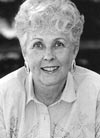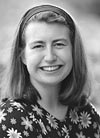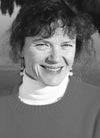Stories By Hope McPherson
Illustration By Stephanie Morgan Rogers
![]()
![]()

ALUMNI AUTHORS SHARE THEIR WORK
![]() your
favorite genre is fiction, biography, travel, theology or something else, a
Seattle Pacific University graduate has likely published in that field.
Throughout the world, SPU alumni have written books that are at this moment
in
someone's hands, sitting on nightstands, or gracing bookshelves, coffee
tables
and school desks. These books share a common thread: The authors care deeply
about
their subjects — and want to share their creativity, knowledge and
vision with
others. Three years ago, Response introduced readers to five such
alumni
authors. Here you'll meet five more, and read excerpts from their work. From
a
new book of fiction for young adults to a ground-breaking study on fire,
these
authors have raised clear and diverse voices in print.
your
favorite genre is fiction, biography, travel, theology or something else, a
Seattle Pacific University graduate has likely published in that field.
Throughout the world, SPU alumni have written books that are at this moment
in
someone's hands, sitting on nightstands, or gracing bookshelves, coffee
tables
and school desks. These books share a common thread: The authors care deeply
about
their subjects — and want to share their creativity, knowledge and
vision with
others. Three years ago, Response introduced readers to five such
alumni
authors. Here you'll meet five more, and read excerpts from their work. From
a
new book of fiction for young adults to a ground-breaking study on fire,
these
authors have raised clear and diverse voices in print.
|
RAY BAKKE '65 believes in vivid word pictures. The executive
director
of International Urban Associates (IUA), Bakke refers to Jesus as an
international
migrant, an Asian-born baby who became a refugee in Africa.
The author of three books, including the recent A Biblical Word for an Urban World, Bakke has also edited two other books and completed several hundred articles for Word in Life Study Bible. He consults and speaks worldwide for IUA in countries such as China, Egypt and the Netherlands. Soon he'll take his message closer to home: Bakke is the keynote speaker for the 2001 Seattle Pacific Alumni Weekend at Casey Conference Center, August 17-19. Via written and spoken words, Bakke strives to inspire others — particularly ministry leaders — to engage in Christian urban mission from a global perspective.
From A Biblical Word for an Urban World When you move into Mexico City from the countryside, your heart beats faster. Not only that, but when you walk down the city street, you don't see things that would grab your attention in a rural town. (Have you ever been driving along and all of a sudden you ask yourself, "Did I stop at the stop sign?") We are fearfully and wonderfully made, says Psalm 139. One of the ways we have been created is to routinize some of the basic tasks in life so they don't take any emotional energy. Otherwise we would hemorrhage emotionally every time somebody new walked into our life. This is what social psychologists call "the elevator syndrome." The more people you pack into an elevator, the less they will communicate. Have you noticed that? Well, the Ford Foundation funded huge studies on it! The fact is that, when people are gathered into a city and we all live closer and closer together, when we walk down the street, we don't even see one another. We walk by signs and we don't see them. Our mind has this capacity to check out. Of course, added to that phenomenon is the cocooning that occurs with people walking around with headsets! So, we must understand that when we come into the city, we are not entering a place where a whole lot of rural people live like rural people. They have been transformed by life in the city, so our mission methodology has to change to account for that change. |
||||
| VERA LOCKHART
GOODMAN '54
has a classroom the size of North America. Retired from teaching in
elementary schools,
Goodman is now an author, speaker, consultant and researcher. Her calling?
To help
create a world in which "every child can read."
Rather than stumble, readers have another option with Reading Is More Than Phonics! Goodman's well-received book, now in its third printing, goes beyond the traditional use of phonics in teaching children to read. Offering practical tips and strategies, she addresses parents who want to help their children succeed as readers — and enjoy books for life. "It's my mission," she says from her home in Calgary, Alberta, Canada.
From Reading Is More Than
Phonics! Read the following words. They are phonetically correct, but are spelled differently from the way you have learned them. You will find this assignment challenging, but don't worry, so does everyone else!
Did you find it impossible, as I did, to read this list with certainty? If you feel frustrated, you may be experiencing the same emotions as your beginning reader when he is asked to sound it out or read words from word lists. Each word has a number of different possibilities, doesn't it? For instance, is sc pronounced sk or s? Even if we could recall all the ways sounds are represented in print we would still not know which to use. Here is a story about baby robins. It contains the words you have just attempted to read from the list. If you have trouble with a word, look away from it and use your experience to think of what word would make sense. "I am working vury hard," said the robin. "I am looking for sctraugh to build my nest. I shall use some mould, too. I shall line it with sought grass. This will make a nice whoamb for my baby birds." So she made the nest in the old apple tree. In a phyue dauss there were three little eggs in the nest. Ceokn there whir three baby robins. They stretched their little pneocquez and cried, "Peep, peep, feed us!" Still rather difficult? But you were probably able to figure out some of the words and with a couple of re-readings you may be able to read the whole passage. Your understanding of the subject helps to limit the possibilities. |
||||
| CHRISTINE UMMEL
HOSLER '93
inhabits both sides of the publishing world. A project editor for
Mountaineers Books
in Seattle, Hosler began her editorial career while a student at SPU when
she undertook
internships at book publisher Epicenter Press and Northwest Health
magazine.
That book about the Northwest's past played a role in her writing about the future. "I've always had a lot of interest in writing fiction," she says. "Grand Hotels was good experience for me, helping me to describe things in a colorful way." The experience is already paying off. Hosler's sci-fi book-in-progress, A Perfect Circle, about a Seattle private detective circa 2100, reached the second round of a national first-novel competition.
From Grand Old Hotels of Washington and
Oregon Usually, though, [John Stafford] McMillin concentrated on more important guests: governors, foreign dignitaries, wealthy businessmen interested in purchasing lime. The visitors stayed at Hotel de Haro, constructed in 1887 around a log bunkhouse the Scurr brothers had built in 1881. (In an archway on the second floor, you can see the wood beams of the bunkhouse inside the hotel walls.) The ornate, white-painted hotel had twenty-two rooms, a triple balcony, and a decorative cupola. During his guests' stay, McMillin would treat them to outdoor salmon barbecues, fashion shows, Christmas dinners, dances on floating barges, and cruises on his fifty-foot yacht. McMillin's most honored guest was Theodore Roosevelt. The president came in 1906 and again in 1907, probably to thank McMillin for his lifelong support of the Republican Party; McMillin was so influential that he was almost elected U.S. senator. (Today you can stay in Room 2B, where Roosevelt stayed, and sleep in the wooden sleigh bed that he used. A portrait of the president hangs over the staircase, and the lobby hotel register displays his signature.) In spite of McMillin's wealth, power, and influential friends, his reign didn't last forever. In 1922, McMillin's oldest son, whom he had groomed to take over for him, died at age forty-two. Just one year later, a fire destroyed the lime plant, the barrel factory, the offices, and the warehouse dock — everything had to be rebuilt. McMillin lost hope in the future of the company and began to focus on constructing an elaborate family mausoleum. |
||||
| JANET CAREY
'81 smiles
as she recounts the uproar in a Seattle fourth grade class. Reading aloud
Molly's Fire,
Carey's young readers' novel set in World War II, the teacher was
approaching the
story's end. Knowing it was time for art class, she closed the book.
"Nooooo,"
the students yelled in unison. "You can't stop now!"
In addition to writing fiction for youth, Carey also writes fantasy and non-fiction. The first book of her new fantasy trilogy is currently with her publisher. And her book for youth about a boy who has a near-death experience, Wenny Has Wings (its working title), will be released by Atheneum Books this spring. Yet Carey often leaves her manuscripts to work with other writers, including future ones. A regular speaker at writers' conferences, she also teaches writers' workshops and visits classrooms, helping others fuel their own creative fires.
From Molly's Fire
Molly fought her way out of a heavy sleep. Something was wrong, terribly wrong. Her eyes opened to the dark, and she remembered. A telegram had come. It said her dad was dead. She got out of bed, her body still slow and heavy from the shot Dr. Richards had given her. She stepped into the hall. The house was quiet. Downstairs, Molly rummaged through the dark closet till her fingers found a rough wool collar. Her father's old coat. She slipped it on and lifted the sleeve to her nose. Sharp smells of seaweed and pipe tobacco filled her nostrils. She tiptoed into the kitchen, picked up the telegram that lay on the table beside the bread basket, and padded across the tile floor to the window. Down the street a dog howled. Another joined in, then another. The sound echoed through Keenan town, out to the cliffs, down to the sea. Molly folded the telegram into a tiny paper airplane and placed it in the sink. The match caught fire with one strike against the stone cutting board. Molly touched the flame to the little yellow plane. The edges burned, slowly turning the paper to a fine gray ash. She watched with deep satisfaction as bits of ash drifted into the air like tiny, tattered moths. |
||||
|
DAVID STROHMAIER '89 had a connection with nine of the 14
firefighters
killed on Colorado's Storm King Mountain in July 1994. The nine were
stationed
in Prineville, Oregon — as he once was. "Through my years at
SPU and my
years of school beyond that, I have worked as a wildland
firefighter,"
he says from his home in Missoula, Montana, where he is writing his second
book
and is a public comment analyst for the U.S. Forest Service.
Having just completed a master's degree in the philosophy of religion at Yale University, Strohmaier explored the literary landscape of fire. Fire, he learned, had been written about either scientifically, in cultural studies or through personal narratives. "I wanted to explore the philosophical nature and divine connections of fire," he says. With The Seasons of Fire, he goes beyond the typical approach and weaves together science, personal narratives and philosophy. "If anything, fire has given me a sense of humility," he says. "I'd be well advised to remember our tenuous hold on life, and that there is more to the world than meets the eye."
From The Seasons
of Fire: Reflections on Fire in the West Even a child knows that a fire can cook hot dogs and marshmallows or incinerate them into hardened chunks of jet-black creosote. This is important, but it is not the whole story. Besides the value of fire's ability to transform matter, there is a value intrinsic to it in only the watching. I'm not even sure if the watching can rightly be called pleasure, though it is valued. The metamorphosis that we witnessed as our campfire developed from a lazy smolder in juniper bark and pine needles to the concentrated heat that would cause pockets of pitch to boil on chunks of gnarled and knotty limb wood evidenced something that wind and water are hard-pressed to do: proclaim a secret about the world — life is fire. Fire's window into reality provides a view into the potential of the world. Within the growth rings of dried wood lies the ability to put forth heat and light, to become brittle in its own pulsating glow, and, after giving up most of its weight and mass, to remain as a still-warm but cooling pile of ashy flakes and blackened charcoal bits. To see this, to feel and smell that this is a natural part of the world < punctuating the drone of sameness with radical transformation — satisfies a need to know about the world and dazzles us with a knowledge that all is not what it sometimes seems. |
||||
Editor's Note: To order any of the alumni books
listed
here, click on the book titles above the excerpts. Each book's title is linked to
a site where
you can order it online.
To be considered for inclusion in a future feature on alumni authors, send a
copy of
your published book, article or poem to Editor, Response,
Seattle Pacific University,
Seattle, Washington 98119.
![]()

| Please
read our
disclaimer.
Send any questions, comments or correspondence about Response to
jgilnett@spu.edu or call 206-281-2051. Copyright © 2001 University Communications, Seattle Pacific University.
Seattle Pacific University |
 That image
speaks to his seminary students in
Seattle; Vancouver, British Columbia; and Manila, Philippines. It also
resonates
with inner-city audiences from the Northwest to Chicago — where Bakke
lived
and taught for 35 years before relocating to Bremerton, Washington, in 2000.
That image
speaks to his seminary students in
Seattle; Vancouver, British Columbia; and Manila, Philippines. It also
resonates
with inner-city audiences from the Northwest to Chicago — where Bakke
lived
and taught for 35 years before relocating to Bremerton, Washington, in 2000.
 Yet the written word frustrates many
children.
Parents are frustrated, too, watching their children hunkered down over a
page,
grimly sounding out each word. And good luck sounding out English, says
Good-man.
It brims with words such as "yacht," "hiccough" and "dough."
Yet the written word frustrates many
children.
Parents are frustrated, too, watching their children hunkered down over a
page,
grimly sounding out each word. And good luck sounding out English, says
Good-man.
It brims with words such as "yacht," "hiccough" and "dough."
 She is also an author. While at Epicenter
Press, Hosler wrote a book detailing historic Northwest hotels, including
Lake Crescent Lodge in Port Angeles, Hotel Planter in La Conner and Roche
Harbor's Hotel de Haro.
She is also an author. While at Epicenter
Press, Hosler wrote a book detailing historic Northwest hotels, including
Lake Crescent Lodge in Port Angeles, Hotel Planter in La Conner and Roche
Harbor's Hotel de Haro.
 The children's reaction, says Carey, was a
wonderful reward. Her story of a young girl whose father is missing in
Europe had come alive for the students.
The children's reaction, says Carey, was a
wonderful reward. Her story of a young girl whose father is missing in
Europe had come alive for the students.
 Fighting forest fires has been a summertime
job for Strohmaier since 1985. But following the Storm King tragedy he
considered fire's power anew and began writing The Seasons of Fire.
Fighting forest fires has been a summertime
job for Strohmaier since 1985. But following the Storm King tragedy he
considered fire's power anew and began writing The Seasons of Fire.